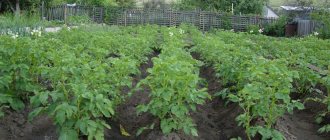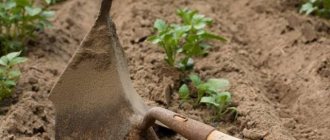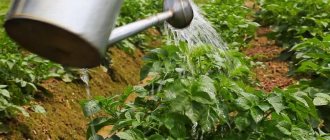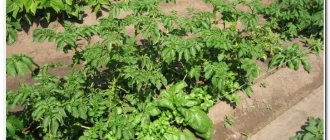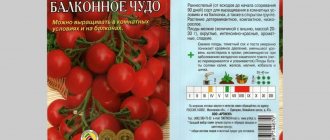Potato growing in Russia
One of the features of our potato production is the predominance of private farms, traditionally characterized by their low efficiency due to the high share of manual labor.
In recent years, large-scale potato production has been increasingly developing, demonstrating much higher yields due to the possibility of using technologies and scientifically based soil fertilization rates.
Another characteristic feature of recent years is the reduction of areas allocated for growing potatoes. But the increase in yield has so far made it possible to fully compensate for the decrease in planting area.
However, in order to catch up with developed countries, we will have to more than double the current yield. This is not easy as competition in agricultural markets has intensified and fuel prices are rising rapidly.
In addition, as usual, the technical support of the industry lags behind. All this has led to the fact that the weakest manufacturers leave, unable to withstand the competition, and those who remain are forced to constantly think about increasing production efficiency.
Russia is the traditional leader in gross potato production, producing 11% of the world's harvest. At the same time, 70-80% of the product in unprocessed form is used for personal consumption.
Industrial processing in Russia is very poorly developed, not exceeding a few percent. According to forecasts, the next redistribution of the potato market in Russia will be associated with the development of processing of this vegetable.
What is the average consumption per 1 hectare and per 1 hundred square meters for different planting methods?
One of the decisive factors in calculating the potato norm is the planting method: single or double rows. They differ in their nuances.
Single rows
Planting in single rows is the most traditional way to grow potatoes. In this case, the row spacing is from 70 to 90 cm (due to the dimensions of the agricultural machinery), the distance between the holes will be approximately 25–45 cm.
If we take a hundred square meters (100 square meters) for calculation - a conventional plot of 12.5 × 8 m, provided that the distance between the rows is 80 cm, and there are an average of 10 rows in total, and their length is 125 m, we get 1250. Each seed tuber must have at least 5 eyes. Divide 1250 by 5, we get 250 tubers.
For large sown areas, calculations are also carried out. An average of 65 thousand tubers are sown per hectare of area.
- If the seeds are 30-50 g , then you will need 2500-2800 kg (2.5-2.8 tons) per hectare (approximately 65-70 thousand tubers).
- If the weight is 50-80 g , the consumption will be 3000-4500 kg (3-4.5 tons) per hectare (on average 55-60 thousand tubers).
Double rows
There are several techniques for planting in double rows. But in any case, the width of the double beds is approximately 40-45 cm, and the distance from bed to bed is 90-110 cm, between bushes - approximately 30 cm. To determine the consumption of seed in this case, add up the width of the bed and the distance between the beds, and divide the length of the section by the resulting number.
Provided that the width of the bed is 45 cm, and the distance between the beds is 90 cm, and 7 beds will fit on 1 acre (74 per hectare). On a 10-meter double row you can plant 66 bushes.
- This means that for 1 hundred square meters you will need 462 tubers - approximately 367 kilograms.
- Per hectare - 49,284 potatoes, which is equal to 3.9 tons of seeds.
Main potato pests
The Colorado potato beetle is one of the main potato pests. In small areas, they fight it manually, collecting beetles, pupae and larvae in a container with kerosene, formaldehyde or strong saline solution. In large areas, 80% dilor or chlorophos is used. The best time for chemical treatment is the beginning of the reproduction of the second or third instar larvae.
The potato nematode often attacks potatoes. Its larvae harm both the roots and tubers of the plant. Nematode cysts are found in the ground, on the roots of potatoes, and contain 200-1000 eggs each. Externally, the plant looks sick, the lower leaves die, the rest quickly wither. Cysts can remain viable for up to 10 years or more. In infected areas, quarantine measures are usually observed and legumes, grains and vegetables are not cultivated for up to four years. Pest control also does not allow the use of contaminated seeds and tools used to cultivate the soil.
Wireworms are the larvae of click beetles that damage roots and tubers. To combat it, traps are set, creating small grass heaps in the garden. Beetles collect in them, which are subsequently destroyed. Weeding also helps; it is especially important to destroy wheatgrass.
The mole cricket is a large brown parasite that makes nests at a depth of 10-15 cm. This pest gnaws everything: roots, stems, tubers, as well as seeds and other root crops. To combat it, you need to dig up the soil in the fall to a depth of at least 25 cm. Manure baits also help. In cases of intense soil damage, benzophosphate is used.
Potato pest control should be the focus of anyone who grows it, otherwise the entire crop could be lost.
Profitability of the potato business
If you invest 80,000 rubles in production, you can get a potato yield from 1 hectare of 20 tons. At the same time, only 7-8 tons of wheat can be harvested from the same area, which will provide approximately 60-65 thousand rubles. arrived. If new technologies are used, the potato yield per 1 hectare can reach 80 t/ha, and the income, accordingly, can reach 800 thousand rubles!
Experts have calculated what is needed to grow 100-240% profitable potatoes. A business plan for its production must take into account a field area of at least 250 hectares, and financial investments - at the level of $7 million, and also working capital in the amount of $0.5-1 million. Over the past year, the profitability of this business in Russia was 40-60 %.
According to the same experts, a potato growing project pays off on average in 5-7 years, and intermediate results are not always indicative. Throughout the entire period of activity, systematic and serious investments are required. For example, the cost of a combine is about 300 thousand euros, a planter costs 80 thousand euros, etc. Soviet technology is already outdated and can lead to crop damage.
But all this concerns industrial production. For individual farms, there are schemes with a low level of investment, but also with lower profitability.
How many potatoes do you need?
How much planting material is needed for a certain area will depend on several conditions:
- potato varieties;
- tuber fractions;
- soil fertility;
- regional climate;
- growing method.
When planting, use either whole tubers or segments with eyes (rudimentary shoots). In the first case, it is possible to calculate the average consumption of seed material per piece and by weight with a known sowing area. Let's try to figure out what needs to be taken into account and what the calculations depend on.
Related article: How to deal with potato wireworm - effective methods
Per hundred (in kg)
Let's take a conventional square plot of 10x10 meters (one hundred square meters). It can consist of 14 rows, and usually a distance of 60 to 80 cm is left between the rows. As a rule, 30-50 cm are left between the tubers. Thus, 28 potatoes can be planted in a 10-meter row. We multiply 14 by 28, we get 392 tubers per hundred square meters.
- Provided that each tuber weighs an average of 90 grams, 35 kilograms of potatoes will be required per hundred square meters.
- If the weight of seed tubers is approximately 70–80 g, you need to proceed at a rate of approximately 27–29 kilograms per hundred square meters.
- If the weight is less, then the consumption per hundred square meters will be about 25-30 kilograms per hundred square meters.
Per hectare (tons)
For large areas, agronomists use special tables. According to them, approximately 60-65 thousand tubers are planted per hectare. But it is worth taking into account the error in the size of planting material, damage to seeds during storage, and making calculations with a small margin.
- The recommended planting quantity is 2000-2500 kilograms, that is, 2-2.5 tons of planting material per hectare with an average tuber with a diameter of 4-6 cm.
- For a small tuber of 2.8–3.5 cm, it is recommended to plant 1500–1800 kilograms, that is, 1.5–1.8 tons of potatoes per hectare.
- With a weight of 80 grams of each potato, the consumption rate will already be 4800 kilograms per hectare, which is 4.8 tons per hectare.
Business plan for home plot
The technology for producing potatoes on a personal plot has its own characteristics. First, let's try to calculate at least the approximate profitability of the potato business under these conditions. To do this, you need to analyze the expected costs. Then it makes sense to calculate the profit margin, taking into account the average potato yield per 1 hectare and wholesale prices. After this, to obtain the amount of net income, you need to subtract the first from the second figure. An approximate calculation for a plot of 0.5 hectares would look like this.
| Walk-behind tractor: plow, cultivator, hiller, potato digger | $700 |
| Planting material | $600 |
| Fertilizers and protection products | $150 |
| Transport | $50 |
| Total: | $1500 |
Thus, all preliminary expenses fit into the amount of 1.5 thousand dollars. With an average yield of 200 kg per hundred square meters and an average wholesale purchase price for potatoes of $0.2 per 1 kg, you can get 2 thousand dollars from sales in the first year. Since equipment is purchased for more than one year, in subsequent years you can have much more profitable potatoes. The price for it, as practice shows, is only growing.
Required number of seeds
Healthy medium-sized tubers are used as planting material. Large and small potatoes are removed. If this is not possible, then the summer resident should remove the tubers that are too small, and cut the large ones into 2 or 3 parts.
See also
Description of potato variety Ivan da Marya, planting rules and care
Read
Material of poor quality is removed, since it can destroy the entire crop by infecting the planting with fungal diseases and pests.
Industrial methods of potato production
Potato production technology using modern methods has already made it possible to significantly increase the efficiency of the potato production industry today. Now it’s time to use industrial methods of growing it. This concept means the following principles.
- The volume of production is planned in advance, and the calculations are justified.
- All quality indicators are calculated and set before planting.
- The harvest is obtained in strict accordance with the planned dates.
All this is achieved through the use of industrial methods consisting of the following elements.
- Various organizational and technical improvements ensure high productivity, which ultimately minimizes production costs.
- The active use of various technological methods makes it possible to almost cancel the influence of adverse weather conditions.
- Minimizing the impact of the human factor on the result of the production process through the use of technical means and methods.
- High average potato yields are achieved through the introduction of management tools and operational control. Technological techniques that make it possible to ensure the planned quantity of products also play an important role.
Right now there is every opportunity to switch to industrial methods in potato growing. The following factors contribute to this:
- market needs for a quality product are constantly growing;
- the number of workers in agriculture, as well as their skill level, is declining;
- the equipment market allows businesses to purchase machines capable of implementing the industrial method;
- the availability of advanced global technical achievements allows for a transition to a completely new level of potato cultivation.
The effectiveness of technical solutions should not depend on the size of the farm and its specifics. The solution to the complex task of transitioning to industrial methods should be implemented on the basis of the best domestic and foreign experience, as well as highly professional recommendations from specialists.
Preparing tubers for planting
In order to get the maximum potato yield, you need to take a responsible approach to the selection of planting material and its preparation. High-yielding, mid-season or late-ripening potato varieties are ideal for growing using the Kvartalnova method. It is also advisable to choose a variety that is resistant to scab.
- Disease-resistant potato varieties (photos and descriptions)
Do you want to know how to protect your potato crop from diseases? How to choose a variety that is not afraid of scab, late blight or Alternaria?
Tubers must be prepared in advance for planting. 30-45 days before this, they are germinated in the light in a cool room with a temperature of 12-15°C.
When the vernalization process comes to an end, the tubers are planted on top of the filled ditches and sprinkled with a layer of earth 10-12 cm thick. For work, it is better to use a light hoe or rake so as not to damage the structure of the plantings. If you did everything correctly, the mounds will almost be level with the surface.
How to increase potato yields
There are many factors affecting potato yield. Some of them are listed below.
- The quality of planting material must be high.
- Potatoes have always placed high demands on the soil, especially on its air regime. That is why it is so important to hill it in a timely manner to increase productivity. If you hill up and loosen the plantings several times over the summer, then even loamy soils are not a problem. Do not forget that the best time for hilling is when the plant height is from 5 to 20 cm. When hilling, the yield increases due to an increase in the number and size of tubers. If you miss the favorable period for this, then an increase in yield will become possible only due to an increase in the mass of tubers.
- When planting potatoes, row spacing should be at least 90 cm.
- During the period of flowering and vigorous growth of tubers, it is important to provide a large amount of water, 10-15 liters per bush.
- During flowering and budding, it is good to fertilize. Norms per bush: 3-6 g of superphosphate, 3-4 g of potassium sulfate, 1-3 g of saltpeter or urea, wood or peat ash. It is good to feed with bird droppings or mullein to guarantee high-quality potatoes. The price of these fertilizers is low. For example, mullein can be bought for 40 rubles per 5 liters.
- To improve health during the flowering period, it is recommended to remove diseased bushes, as well as impurities from non-varietal potatoes. This will increase productivity by 10-20% per year.
- During the budding phase, it is useful to remove all flower stalks; this also increases the yield.
Calculation for large areas
The rate of planting potatoes for the fields of agricultural enterprises or farms is calculated in a similar way. However, generally accepted measures are used to simplify calculations. There are tables compiled by employees of agricultural enterprises. So, approximately 60,000-65,000 tubers are planted per hectare. If the weight of one tuber is 80 g, then the consumption rate is 4800 kg/ha. If converted to centners, then this is 48 centners per 1 hectare.
Potato planting rate
Related article: Why potatoes (tops) wither - reasons and solutions
Potatoes in fields measured in hectares are planted in rows with a large distance between them (from 70 to 100 cm). This is necessary so that equipment, such as a tractor, can pass through. It is used to plant and harvest crops.
Application of fertilizers for potatoes
First of all, it is important to remember that during growth, potatoes pull from the ground approximately 50 kg of nitrogen, 20 kg of phosphorus and 90 kg of potassium per 10 tons of product. Therefore, it is these mineral fertilizers that should be regularly applied to the soil so that it does not become depleted and can provide the potatoes with the nutrition they need.
Nitrogen helps the active growth of the plant and the supply of carbohydrates to the tubers.
Phosphorus increases resistance to drought, develops the root system and accumulates starch in tubers, and promotes their early ripening.
Potassium causes an increase in carbohydrates in tubers and increases resistance to weather conditions.
When fertilizing the soil, it is important to maintain the right balance. With a lack of potassium, for example, nitrogen is poorly absorbed. In addition, an excess of any fertilizer can be no less harmful than a deficiency.
In terms of timing, it is recommended to apply fertilizers in the central regions in July, in the northern regions in July-August, and in the south in June.
Agronomists do not recommend using organic fertilizers, although they double the yield, due to the risk of scab infection or the ingress of cockchafer larvae. It is better to use peat manure composts.
As a fertilizer for potatoes in the fall, double superphosphate (1 kg per hundred square meters) and potassium sulfate (2 kg per hundred square meters) are recommended.
In spring, it is good to fertilize potatoes with urea and saltpeter (1 kg per hundred square meters). You can also use complex fertilizers: nitrophoska 5 kg per hundred square meters and nitroammophoska 3 kg.
Bone meal is an excellent form of fertilizer for potatoes in the fall, and it also improves the taste of the product. And at this time it is also useful to fertilize the soil with superphosphate and potato kemira, this universal potato fertilizer.
One of the natural nutrients that is ideal for potatoes is wood ash. In addition to nourishment, it will also protect against many diseases and decay. So it’s best to start with ash and nitrophoska, and then look at the results. Too much fertilizer is bad for plants.
The best potato varieties
For planting, it is better to take varietal tubers. They are more expensive than random ones, but they guarantee good taste and a healthy harvest.
At any summer cottage there are always early ripening potato bushes, which can be dug up from mid-summer. Among the early varieties we can distinguish such as Timo, Ariel, Zhavoronok, Bullfinch, Udacha, as well as mid-early ones - Sudarynya and Prizer.
The once popular, boiled white-fleshed variety Sineglazka has low potential and is considered a fodder variety in Europe.
For those who care about their health, we can safely recommend varieties such as the Dutch Mona Lisa, Fresco, Romano, the German Arosa, Rosara, Felox, the Finnish Timo, Asterix. These varieties contain a lot of carotene, which improves vision.
And you can safely focus on your taste. Scientists have found that tasty varieties contain much more amino acids, nucleotides and fatty acids!
In the competition for the best taste, the championship is held by such varieties as Borodyansky pink, Bullfinch, Adretta, Aurora, Golubizna, Vesnyanka, Temp.
Particularly worth highlighting is the Zhukovsky variety. Potatoes are classified as early varieties that grow well at low temperatures. It is resistant to many diseases, has a smooth peel, is stored for a long time and has a great taste.
Bellarosa potatoes, bred by German breeders, are recommended for cultivation in Eastern European countries. This is an early variety, it can be dug up already on the 45th day. It is very profitable: potato yield per 1 hectare is 400 centners!
The Bellarosa variety is almost not susceptible to pests, does not require moisture, is resistant to drought, grows on any soil except heavy clay, and is not lost during storage (93%). It has large, even tubers, excellent taste and high friability.
How to properly store potatoes
When storing potatoes, it is very important not to allow the tubers to rot or begin to sprout. Therefore, it is better to store it in a cold and dry place, which is well ventilated.
You need to be especially careful in the spring, when the tubers lose their mass, their appearance deteriorates and the amount of vitamins decreases. During this period, potatoes must be monitored and regularly checked for spoilage.
The potato storage process can be divided into 3 stages.
- Keep in storage for two weeks at tо +15°. At the same time, the tubers heal, and some of the moisture leaves them.
- Until the end of winter, the potatoes seem to “sleep”; the best temperature for storage is from 3 to 5°C.
- With the onset of spring, the tubers begin to prepare for germination. During this time, the storage temperature can be increased by several degrees.
